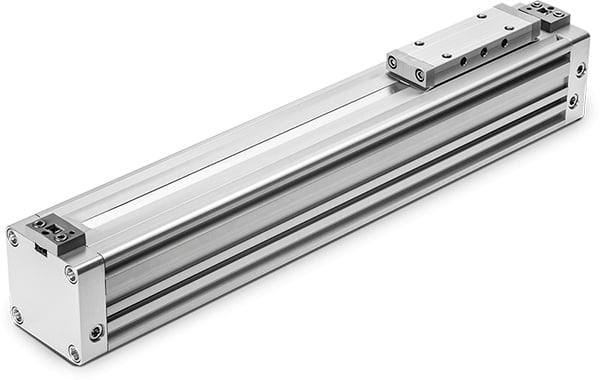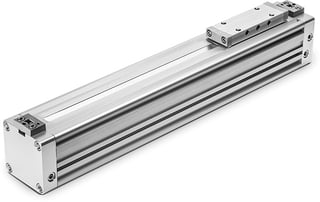
 In a recent blog article, we listed some questions you should ask when you want to use pneumatic rod cylinders in your mechanical design. For many applications, however, rodless cylinders are a better choice. With this type of pneumatic cylinder, the external carriage itself slides back and forth along the cylinder body, rather than an external rod extending and retracting. This design is particularly useful for applications that require long strokes or high moment loads, thanks to the shorter, enclosed and self-guided configuration.
In a recent blog article, we listed some questions you should ask when you want to use pneumatic rod cylinders in your mechanical design. For many applications, however, rodless cylinders are a better choice. With this type of pneumatic cylinder, the external carriage itself slides back and forth along the cylinder body, rather than an external rod extending and retracting. This design is particularly useful for applications that require long strokes or high moment loads, thanks to the shorter, enclosed and self-guided configuration.
Here at W.C. Branham, we offer three types of pneumatic rodless cylinders:
- PNEUSA® Rodless Cylinders use cables to connect the piston and carrier, which are housed separately. This design ensures the cables and main seal are enclosed and protected from the operating environment.
- MAGTEC® Rodless Cylinders also feature an entirely closed operating body, protecting both interior and exterior critical components from contaminants. This design uses magnetic coupling between the piston and carriage instead of cables. There are also stainless steel configurations avaible with this type of cylinder.
- DURATRKTM Rodless Cylinders are lightweight without sacrificing structural integrity. Multiple models and customizing options make it easy to meet special space, load, and other needs. This cylinder type has the widest bore size available. Six bores ranging from 18mm to 63mm diameter.
Specification Considerations
Once you’ve determined pneumatic rodless cylinders are the best solution for your automation needs, there are several factors to consider, in order to properly incorporate them into your mechanical design.
- How much space is available? Moving parts must be able to operate freely. Pneumatic rodless cylinders save space because there is no need to accommodate rod extension outside the envelope. Space needs should also consider operator safety, if there will be one, and ensure enough room for convenient maintenance.
- How much force will be required? Bore size and the amount of PSI used determine the amount force the cylinder produces. You’ll also need to know the load weight. If the moving load is externally guided and supported, the sliding coefficient of friction will also help the sizing process to determine the force required. (For example, if the horizontal load weighs 200 lbs and the sliding coefficient is .2, then 40 lbf is required to move the load.) You can begin to look for a bore size that will produce a minimum of 40 lbf If the moving load is vertical, then you’ll need a cylinder capable of producing 200 lbf at minimum. (Note: For magnetically coupled cylinders, you’ll need to take a look at the magnet decoupling rating and avoid exceeding that. For cable operated cylinders, you should look at a cylinder where 20% of the tensile breaking strength of the cable doesn’t exceed the force needed.)
- At what speed will the cylinder need to operate? You want maximum productivity, but you need to think about cylinder life and your ability to control the operation. Port size, flow-through control valves, the size of tubing or hoses, and inadequate air pressure can reduce speed. You also need to make sure that the cylinder can adequately dampen the force upon deceleration, so look at the capability of the cylinder’s internal cushions or determine if external shock absorbers are necessary.
- How much air will be consumed? This depends on the volume displaced by the piston as well as unswept volume.
- Do you want port(s) to be located on one end? Both ends? The bottom? Bore size is a key factor here.
- What will the operating environment be like? Factors such as dust, extreme temperatures, humidity, and the need to periodically wash equipment all affect your choice of cylinder as well as the material it’s made from for maximum service life.
- Will you need specialized seals? Standard materials can be replaced with alternatives for environments that are very hot or cold or in which caustic chemicals are present.
Every application and environment are different. We’re here to help you find the ideal solution. Our on-staff design engineers are always happy to answer your questions. They can also help you identify custom modifications to ensure optimum, long-lasting performance from the pneumatic rodless cylinders you choose for your mechanical design.


